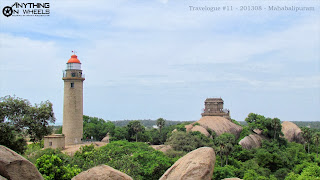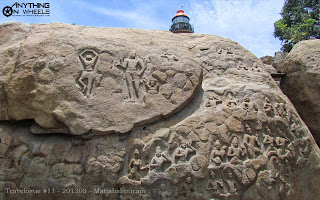India might not fare well in modern architecture but our country, in ages gone by, undoubtedly possessed the best of everything. Mahabalipuram, also called Mamallapuram, is a feel-good destination that not only proves that point but also makes us proud of our legacy. Famous for its magnificent structures carved and cut out of huge rocks that are spread over a few square kilometers adjacent to the Bay of Bengal on the east coast of India south of Chennai, the monuments of Mahabalipuram are declared a "World Heritage Site" by UNESCO. And quite deservedly so, if we are eligible to say that.
It's not without reason Mahabalipuram is one of the most popular destinations in India for tourists from other countries. The moment you venture left off the ECR, this historic town mesmerizes with its grandeur and splendor. Believed to be built between the 7th and 9th centuries by the Pallava dynasty who ruled this part of the country, Mahabalipuram is a symbol of beauty and a shining example of the architectural skills of our great ancestors. It's a pity then, that we depend on architects from other countries for building our cities these days.
The Shore Temple, by far the most popular monument in Mahabalipuram, is a majestic structure that stands tall adjacent to the sea. Being a structural stone temple built out of blocks of granite, the Shore Temple is different from the other monuments in the town that are rock-cut. It's not uncommon to hear instances of the ocean waves crashing on the temple walls during high tides. This continuous hammering for centuries has slowly eroded the structure, which is evident from the smoothened and blunt surfaces that have lost definition. A recent exploration off the coast of Mahabalipuram has uncovered remains of similar temple complexes under water, hinting that the "seven pagodas", as ancient European explorers apparently called Mahabalipuram referring to the seven structures, is not just a myth.
The Pancha Rathas, which means 'five chariots' in English, is yet another must-see destination in Mahabalipuram. Each of the five rathas are made out of a single stone and are named after the Mahabaratha fame Pancha Pandavas and their wife Draupati. It is believed that these rathas are incomplete and have no connection with the epic Mahabaratha, despite carrying those names. Whatever it is, the five rathas are a sight to behold and, quite understandably, is one of the 'most photographed' structures in India. Walk across the road and enter the commercial complex that's lined up with small shops that sell colorful stone-made items and souvenirs.
Between the Shore Temple and the Pancha Rathas is the Descent of the Ganges or Arjuna's Penance, a huge, glorious, open-air bas-relief that has a crevice at the center intended to depict the descent of the river Ganges to Earth. Another interpretation is that the figure standing on one leg in the structure is that of Arjuna who is performing a tapas to receive a boon from Lord Shiva. A total of 146 carvings including scores of gods, goddesses, mythical figures and animals are immortalized in this structure. The life-size carvings of elephants in this monument are one of Mahabalipuram's post-card images and considered to be amongst the best animal carvings in India.
Just behind the Descent of Ganges is a big complex that has a series of intricately carved caves. Mandapams, as they are called in Tamil, are pillared structures that are cut into rocks, giving the impression of a cave. Varaha Caves, Rayar Gopuram, Ramanuja Mandapam, Ganesha Ratha and a huge stone called 'Krishna's Butterball' that's perched precariously over an open rocky hillock are all interesting and attractive in their own ways. The Light House and Mahishasuramardhini Mandapam inside the same complex are very popular monuments for the awesome views that they offer and get really crowded on weekends.
Unlike many other tourist destinations, Mahabalipuram is at its best when the sun is shining hot. The sunlight brings out the glory of these monuments spectacularly, as is evident from the images posted below. But, there is a flip side to it. The ruthless Chennai weather drowns your energy levels, so much so, you get tired after just a couple of hours. Don't get bogged down though. The beauty and sheer magnificence of these monuments will keep you in a high.
Following in the footsteps of our previous travelogues that took us to Puducherry and Pitchavaram, Mahabalipuram is the third beautiful destination in the East Coast Road. We have made no secret of the fact that we love the ECR and never miss an opportunity to drive along this scenic two-lane highway that runs parallel to the coast. And every time we go there, the road reminds us to stay alert, drive within the limits and get back home with the widest possible grin. This time, it was a toppled Mahindra Scorpio that gave us a grim reminder of what the ECR is capable of doing.
It's not without reason Mahabalipuram is one of the most popular destinations in India for tourists from other countries. The moment you venture left off the ECR, this historic town mesmerizes with its grandeur and splendor. Believed to be built between the 7th and 9th centuries by the Pallava dynasty who ruled this part of the country, Mahabalipuram is a symbol of beauty and a shining example of the architectural skills of our great ancestors. It's a pity then, that we depend on architects from other countries for building our cities these days.
The Shore Temple, by far the most popular monument in Mahabalipuram, is a majestic structure that stands tall adjacent to the sea. Being a structural stone temple built out of blocks of granite, the Shore Temple is different from the other monuments in the town that are rock-cut. It's not uncommon to hear instances of the ocean waves crashing on the temple walls during high tides. This continuous hammering for centuries has slowly eroded the structure, which is evident from the smoothened and blunt surfaces that have lost definition. A recent exploration off the coast of Mahabalipuram has uncovered remains of similar temple complexes under water, hinting that the "seven pagodas", as ancient European explorers apparently called Mahabalipuram referring to the seven structures, is not just a myth.
The Pancha Rathas, which means 'five chariots' in English, is yet another must-see destination in Mahabalipuram. Each of the five rathas are made out of a single stone and are named after the Mahabaratha fame Pancha Pandavas and their wife Draupati. It is believed that these rathas are incomplete and have no connection with the epic Mahabaratha, despite carrying those names. Whatever it is, the five rathas are a sight to behold and, quite understandably, is one of the 'most photographed' structures in India. Walk across the road and enter the commercial complex that's lined up with small shops that sell colorful stone-made items and souvenirs.
Between the Shore Temple and the Pancha Rathas is the Descent of the Ganges or Arjuna's Penance, a huge, glorious, open-air bas-relief that has a crevice at the center intended to depict the descent of the river Ganges to Earth. Another interpretation is that the figure standing on one leg in the structure is that of Arjuna who is performing a tapas to receive a boon from Lord Shiva. A total of 146 carvings including scores of gods, goddesses, mythical figures and animals are immortalized in this structure. The life-size carvings of elephants in this monument are one of Mahabalipuram's post-card images and considered to be amongst the best animal carvings in India.
Just behind the Descent of Ganges is a big complex that has a series of intricately carved caves. Mandapams, as they are called in Tamil, are pillared structures that are cut into rocks, giving the impression of a cave. Varaha Caves, Rayar Gopuram, Ramanuja Mandapam, Ganesha Ratha and a huge stone called 'Krishna's Butterball' that's perched precariously over an open rocky hillock are all interesting and attractive in their own ways. The Light House and Mahishasuramardhini Mandapam inside the same complex are very popular monuments for the awesome views that they offer and get really crowded on weekends.
Unlike many other tourist destinations, Mahabalipuram is at its best when the sun is shining hot. The sunlight brings out the glory of these monuments spectacularly, as is evident from the images posted below. But, there is a flip side to it. The ruthless Chennai weather drowns your energy levels, so much so, you get tired after just a couple of hours. Don't get bogged down though. The beauty and sheer magnificence of these monuments will keep you in a high.
Following in the footsteps of our previous travelogues that took us to Puducherry and Pitchavaram, Mahabalipuram is the third beautiful destination in the East Coast Road. We have made no secret of the fact that we love the ECR and never miss an opportunity to drive along this scenic two-lane highway that runs parallel to the coast. And every time we go there, the road reminds us to stay alert, drive within the limits and get back home with the widest possible grin. This time, it was a toppled Mahindra Scorpio that gave us a grim reminder of what the ECR is capable of doing.
ROUTEMAP:
FACTFILE:
* Total No of Days: 1 (18.08.2013)
* Vehicle Make & Model: Honda Civic
* Odometer Start Reading: 53064 km
* Odometer End Reading: 53196 km
* Total Distance traveled: 132 km
* No of Toll Booths: 2
* Money spent on Toll & Parking: Rs. 118
* Total Quantity of Fuel filled: 12.84 l
* Average Fuel Consumption: 10.28 km/l
* Money spent on Fuel: Rs. 958
* Destinations Covered: Mahabalipuram
* Route Followed: Chennai-Sholinganallur-Mahabalipuram
THE LANDSCAPE:
THE AUTOMOBILE:
Despite visiting this coastal town atleast a couple of times in the recent past, this was the first time we managed to cover its complete grandeur on a single day. Needless to say, it's an experience that is going to stay in our minds forever! Anything On Wheels is here to stay. So, stop staring at this post now and start planning your trip to Mahabalipuram. And if you happen to be in Chennai, all you need is a moisturizer tube and a sun-glass to head out!



























No comments:
Post a Comment